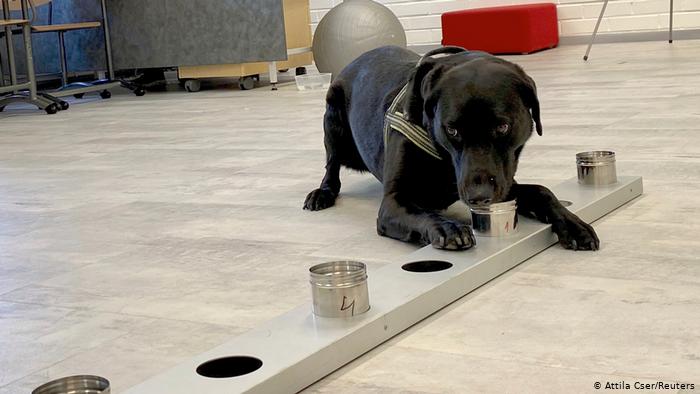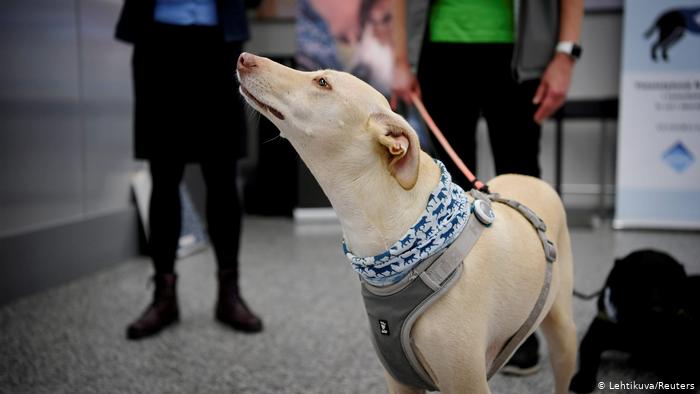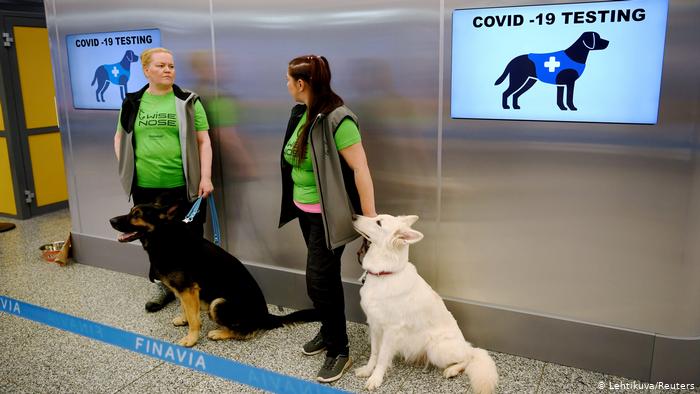Why not use them everywhere?
Finnish researchers say their canine sniffer experts can detect COVID-19 quickly and cheaply but, so far, their skills are hardly used to control the pandemic. Teri Schultz wonders: Who isn’t letting the dogs out?
Written content from DW
Europe is in a panic over the second wave of COVID-19, with infection rates sky-rocketing and GDP plummeting. Belgium has just announced it will no longer test asymptomatic people, even if they’ve been in contact with someone who has the disease, because the backlog in processing is overwhelming. Other European countries are also struggling to keep up testing and tracing.
Meanwhile in a small cabin in Helsinki airport, for his preferred payment of a morsel of cat food, rescue dog Kossi needs just a few seconds to tell whether someone has coronavirus.
If it were left to Kossi and his pals, crowds of potential virus carriers could be cleared in a fraction of the time for a fraction of the cost with none of the physical discomfort that accompanies the current nasal swab test based on the polymerase chain reaction (PCR) method.
No human nose needed
A dog can sniff a cloth wiped on a wrist or neck and immediately identify if it comes from someone who has contracted the virus as much as five days before any symptoms appear which would lead a person to go into isolation. “A dog could easily save so so, so many lives,” University of Helsinki veterinary researcher Anna Hielm-Bjorkman told DW, who says their testing has shown an accuracy level of nearly 100%.

Miina, who used to track a young girl’s blood sugar levels by scent, quickly came on board, along with two others already working in disease detection. In all, they hope to train 15 dogs in the first phase.
Hielm-Bjorkman said once they discovered the new capabilities, while the normal academic procedure would be to test, publish and get peer-reviewed, their first instinct was to get the dogs into service. “[Researchers] who are actually publishing,” she noted wryly, “are not at the airports.”
Wags, not wages

But for that, they needed permission and ideally, some funding. Vantaa Deputy Mayor Timo Aronkyto, who is also responsible for airport security, saw the benefit straight away. “It took me two minutes,” he told DW.
However, his funding options were limited to about $390,000 total for the four-month pilot project aiming to prove that results from the dog tests are at least as accurate as the PCR test. Anyone who tests positive at the voluntary canine site is requested to go to the medical unit for confirmation.
The interest of Aronkyto, a trained physician, is rooted in both health and wealth. “Our testing at the airport costs more than 1 million [euros] a month at the moment,” he said, explaining he expects that to go up to €3 million per month in winter. “These dogs would be much cheaper,” he pointed out.
He’s optimistic support will grow as data from the current pilot project accumulates, explaining there is already work underway to change Finnish legislation so eventually sniffer dogs would have the same “authority” as customs dogs.
Aronkyto anticipates one animal performing both functions in the near future. He plans to continue this level of funding from his city budget into next year but that doesn’t train new dogs nor expand the capacity beyond the four that split shifts currently at the airport, even as infection rates rise. Read more from DW
Read other interesting and unbiased news stories from News Without Politics
Subscribe to News Without Politics





